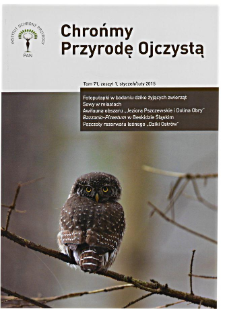- Search in all Repository
- Literature and maps
- Archeology
- Mills database
- Natural sciences
Advanced search
Advanced search
Advanced search
Advanced search
Advanced search

Object
Title: Wykorzystanie nieinwazyjnej metody w badaniu zwierząt na terenie Gorczańskiego Parku Narodowego - pierwsze wyniki z zastosowania fotopułapek ; The study of wildlife in Gorce National Park with the use of a non-invasive technique - the first results of camera-trapping
Creator:
Wierzbowska, Izabela A. ; Loch, Jan ; Armatys, Paweł ; Matysek, Marcin
Date issued/created:
Resource type:
Publisher:
Instytut Ochrony Przyrody Polskiej Akademii Nauk
Place of publishing:
Description:
24 cm ; ilustracje ; bibliografia na stronie 8 ; ISSN 0009-6172
Type of object:
References:
Ancrenaz M., Hearn A.J., Ross J., Sollmann R., Wilting A. 2012. Handbook for wildlife monitoring using camera-traps. BBEC II Secretariat, Kota Kinabalu, Sabah, Malaysia.
Clevenger A.P., Waltho N. 2005. Performance indices to identify attributes of highway crossing structures facilitating movement of large mammals. Biological Conservation 121: 453–464.
Galaverni M., Palumbo D., Fabbri E., Caniglia R., Greco C., Randi E. 2011. Monitoring wolves (Canis lupus) by non-invasive genetics and camera trapping: a small-scale pilot study. European Journal of Wildlife Research 58: 47–58.
Gompper M.E., Kays R.W., Ray J.C., Lapoint S.D., Bogan D.A., Cryan J.R. 2006. A comparison of noninvasive techniques to survey carnivore communities in northeastern North America. Wildlife Society Bulletin 34: 1142–1151.
Kays R.W., Slauson K.M. 2008. Remote cameras. W: Long R.A., MacKay P., Zielinski W.J., Ray J.C. (red.). Noinvise survey methods for carnivores. Island Press, Washington, Covelo, London: 110–140.
Kuijper D.P.J., Verwijmeren M., Churski M., Zbyryt A., Schmidt K., Jędrzejewska B., Smit C. 2014. What cues do ungulates use to assess predation risk in dense temperate forests? PLoS ONE 9 (1): e84607.
Meek P., Ballard G., Fleming P. 2012. An introduction to camera trapping for wildlife surveys in Australia. PestSmart Toolkit publication, Invasive Animals Cooperative Research Centre, Canberra, Australia.
Mendoza E., Martineau P.R., Brenner E., Dirzo R. 2011. A novel method to improve individual animal identification based on camera-trapping data. Journal of Wildlife Management 75: 973–979.
Poszig D.C., Apps C.D., Dibb A. 2004. Predation on two mule deer, Odocoileus hemionus, by a Canada Lynx, Lynx canadensis, in the Southern Canadian Rocky Mountains. Canadian Field-Naturalist 118: 191–194.
Rovero F., Zimmermann F., Berzi D., Meek P. 2013. “Which camera trap type and how many do I need?” A review of camera features and study designs for a range of wildlife research applications. Hystrix 24: 148–156.
Samejima H., Ong R., Lagan P., Kitayama K. 2012. Camera-trapping rates of mammals and birds in a Bornean tropical rainforest under sustainable forest management. Forest Ecology and Management 270: 248–256.
Soisalo M.K., Cavalcanti S.M.C. 2006. Estimating the density of a jaguar population in the Brazilian Pantanal using camera-traps and capture–recapture sampling in combination with GPS radio-telemetry. Biological Conservation 129: 487–496.
Weingarth K., Heibl C., Knauer F., Zimmermann F., Bufka L., Heurich M. 2012. First estimation of Eurasian lynx (Lynx lynx) abundance and density using digital cameras and capture-recapture techniques in a German national park. Animal Biodiversity and Conservation 35 (2): 197–207.
Relation:
Volume:
Issue:
Start page:
End page:
Detailed Resource Type:
Resource Identifier:
Source:
Bibl. IOP PAN, sygn. F 2, II 293/cz, II 324/cz
Language:
Language of abstract:
Rights:
Licencja Creative Commons Uznanie autorstwa 3.0 Polska
Terms of use:
Zasób chroniony prawem autorskim. [CC BY 3.0 PL] Korzystanie dozwolone zgodnie z licencją Creative Commons Uznanie autorstwa 3.0 Polska, której pełne postanowienia dostępne są pod adresem: ; -
Digitizing institution:
Instytut Ochrony Przyrody Polskiej Akademii Nauk
Original in:
Instytut Ochrony Przyrody Polskiej Akademii Nauk
Projects co-financed by:
Access:
Object collections:
- Digital Repository of Scientific Institutes > Partners' collections > Institute of Nature Conservation PAS > Journals
- Digital Repository of Scientific Institutes > Literature > Journals/Articles
Last modified:
Dec 1, 2020
In our library since:
Oct 15, 2020
Number of object content downloads / hits:
117
All available object's versions:
https://rcin.org.pl./publication/162517
Show description in RDF format:
Show description in RDFa format:
Show description in OAI-PMH format:
Objects Similar
Szczepański, Sebastian Santorek, Anna Dulisz, Beata Żurek, Zbigniew Armatys, Paweł Rutkowski, Robert

 INSTYTUT ARCHEOLOGII I ETNOLOGII POLSKIEJ AKADEMII NAUK
INSTYTUT ARCHEOLOGII I ETNOLOGII POLSKIEJ AKADEMII NAUK
 INSTYTUT BADAŃ LITERACKICH POLSKIEJ AKADEMII NAUK
INSTYTUT BADAŃ LITERACKICH POLSKIEJ AKADEMII NAUK
 INSTYTUT BADAWCZY LEŚNICTWA
INSTYTUT BADAWCZY LEŚNICTWA
 INSTYTUT BIOLOGII DOŚWIADCZALNEJ IM. MARCELEGO NENCKIEGO POLSKIEJ AKADEMII NAUK
INSTYTUT BIOLOGII DOŚWIADCZALNEJ IM. MARCELEGO NENCKIEGO POLSKIEJ AKADEMII NAUK
 INSTYTUT BIOLOGII SSAKÓW POLSKIEJ AKADEMII NAUK
INSTYTUT BIOLOGII SSAKÓW POLSKIEJ AKADEMII NAUK
 INSTYTUT CHEMII FIZYCZNEJ PAN
INSTYTUT CHEMII FIZYCZNEJ PAN
 INSTYTUT CHEMII ORGANICZNEJ PAN
INSTYTUT CHEMII ORGANICZNEJ PAN
 INSTYTUT FILOZOFII I SOCJOLOGII PAN
INSTYTUT FILOZOFII I SOCJOLOGII PAN
 INSTYTUT GEOGRAFII I PRZESTRZENNEGO ZAGOSPODAROWANIA PAN
INSTYTUT GEOGRAFII I PRZESTRZENNEGO ZAGOSPODAROWANIA PAN
 INSTYTUT HISTORII im. TADEUSZA MANTEUFFLA POLSKIEJ AKADEMII NAUK
INSTYTUT HISTORII im. TADEUSZA MANTEUFFLA POLSKIEJ AKADEMII NAUK
 INSTYTUT JĘZYKA POLSKIEGO POLSKIEJ AKADEMII NAUK
INSTYTUT JĘZYKA POLSKIEGO POLSKIEJ AKADEMII NAUK
 INSTYTUT MATEMATYCZNY PAN
INSTYTUT MATEMATYCZNY PAN
 INSTYTUT MEDYCYNY DOŚWIADCZALNEJ I KLINICZNEJ IM.MIROSŁAWA MOSSAKOWSKIEGO POLSKIEJ AKADEMII NAUK
INSTYTUT MEDYCYNY DOŚWIADCZALNEJ I KLINICZNEJ IM.MIROSŁAWA MOSSAKOWSKIEGO POLSKIEJ AKADEMII NAUK
 INSTYTUT PODSTAWOWYCH PROBLEMÓW TECHNIKI PAN
INSTYTUT PODSTAWOWYCH PROBLEMÓW TECHNIKI PAN
 INSTYTUT SLAWISTYKI PAN
INSTYTUT SLAWISTYKI PAN
 SIEĆ BADAWCZA ŁUKASIEWICZ - INSTYTUT TECHNOLOGII MATERIAŁÓW ELEKTRONICZNYCH
SIEĆ BADAWCZA ŁUKASIEWICZ - INSTYTUT TECHNOLOGII MATERIAŁÓW ELEKTRONICZNYCH
 MUZEUM I INSTYTUT ZOOLOGII POLSKIEJ AKADEMII NAUK
MUZEUM I INSTYTUT ZOOLOGII POLSKIEJ AKADEMII NAUK
 INSTYTUT BADAŃ SYSTEMOWYCH PAN
INSTYTUT BADAŃ SYSTEMOWYCH PAN
 INSTYTUT BOTANIKI IM. WŁADYSŁAWA SZAFERA POLSKIEJ AKADEMII NAUK
INSTYTUT BOTANIKI IM. WŁADYSŁAWA SZAFERA POLSKIEJ AKADEMII NAUK


































